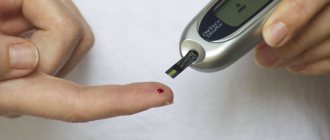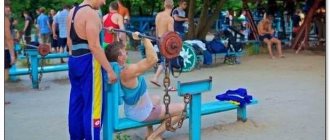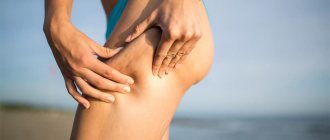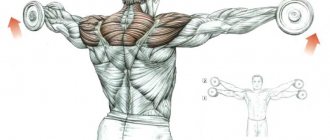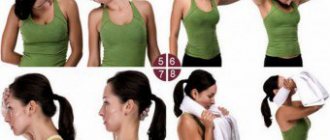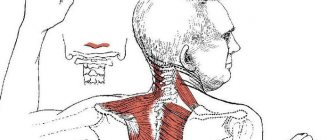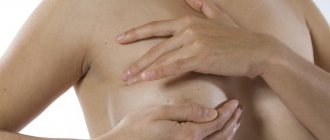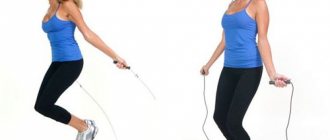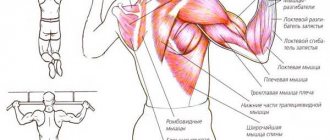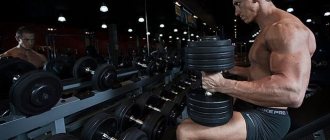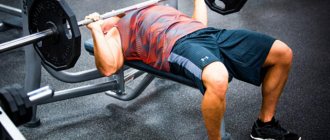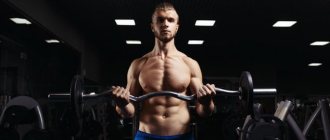MFR or myofascial release is a unique technique of universal importance for experienced athletes and ordinary amateurs who keep their body in good physical shape. This training program provides a whole range of exercises to simultaneously target the muscles and fascia of the body.
The main goal is maximum muscle relaxation. MFR training helps to effectively combat pain and soreness. But more about everything.
What is myofascial release: short video lecture with transcript
Even though the benefits of myofascial release are proven and undeniable, there are still many people who are quite skeptical about this type of exercise. In fact, since there is very little research on the positive effects of myofascial release on tissue, some people think that it is all a marketing ploy, like many other things going on in this world. In this regard, I am often asked what MFR is, which I talk so much about, and what time is best to do it - before training, during or after training. And is it really worth spending your precious time on it?
In fact, the word "myofascial" comes from two words meaning muscle and connective tissue - the membrane that permeates every muscle we have, and literally everything in our body, including our internal organs. This leads to a completely natural conclusion, by the way, already confirmed by many data, that working with connective tissue, with superficial and internal tissues, muscles and fascia really helps improve the quality of movement. But that’s not all, because there are a lot of effects from the influence of MFR, which I would like to talk about in more detail.
Our modern world is designed in such a way that we sit a lot and move very little, and our body, from an evolutionary point of view, has not yet had time to adapt to the new way of life. In fact, by nature itself we are destined to move a lot, to be active in the constant struggle for survival - to escape from a saber-toothed tiger, to climb trees, to chase mammoths, to gather, etc. and so on. Thus, our body physiologically needs movement.
As soon as our lifestyle becomes passive, functional changes begin to occur in the body - the body becomes “rigid”, joints lose their mobility, connective tissue becomes rigid and sticky due to lack of hydration. The latter means that a lot of scars and adhesions form in the fascial tissue, seemingly out of the blue.
As a result, one of the unspoken laws of nature is fulfilled - that which does not move, sooner or later ceases to function . With the help of myofascial release, we have the opportunity to influence our soft tissues, as a result of which adhesions dissolve, swelling disappears, lymph flow and blood microcirculation improve.
Victoria Borovskaya has a very broad educational base:
- FPTI Personal Trainer, Focus Institute of Personal Training.
- Nutritionist for Precision Nutrition and FPA.
- Corrective Exercise Specialist, NASM.
- Fitness therapy through the ISSA movement.
- Specialist in working with the formation of healthy habits Behavior Coach, NASM.
- Specialist in working with the age group of the population (50+) ACE
- Currently: student at Gray Institute: Functional Training & Fitness.
In the arsenal of a professional, there are many devices for MFR - balls and rollers of various types and configurations. Of course, it is not at all necessary to use all this every day. In this matter, progression is important - moving from simple to complex. For those who already practice MFR, soon, for example, one tennis ball will no longer be enough, so balls of different hardness have been invented that can be used to work with some trigger points that prevent you from performing movements in full amplitude. There are also different double balls that are very good for rolling your back along the spine, there are foam rollers, Pilates rollers, long and short Trigger Point Grid rollers, etc. – it all depends on the surface you are working with.
Devices for MFR come in varying degrees of hardness, and I would like to warn beginners against abusing “pimples” and various “grooves.” For beginners, I would recommend using smooth, soft rollers to start with, and only gradually progress over time and move on to using something harder.
We work with all the tissues on our body, starting from the feet and then moving up - to the calf muscles, thighs, back, chest, neck, right up to the aponeurosis, which we must also work with our own fingers.
I sometimes get asked what to do when traveling long distances: it’s difficult to find room in your luggage for a device like a roller skate. But, in fact, the use of devices in this case is not important. It is enough to take with you a small ball, which you use in some releases, or simply stretch yourself with your hands, which also improves the conduction of nerve impulses, making the movement easier and more amplitude.
Features of the technique
The peculiarity of the MFR technique is that this method, in combination with massage, will help in the process of combating excess weight, in the process of forming a toned figure, and also has a beneficial effect on the musculoskeletal system. The training usually takes 1 hour.
Most MFR lovers prefer to attend group or individual training in fitness clubs, under the supervision and mentoring of a trainer.
When practicing myofascial relaxation, you can not only remove tension in the muscles and fascia, but also increase joint mobility and experience general relaxation of the body, despite the fact that some exercises are not easy. Regular exercise will also help get rid of migraines, back pain, restore posture, reduce excitability and overcome stress.
Contraindications for MFR
It is impossible not to mention several contraindications for myofascial release exercises. Those who have a confirmed diagnosis of varicose veins .
In addition, it is better for pregnant women to consult a doctor first .
And there is also a very important point - when we, so to speak, roll various parts of the body, under no circumstances should we go into bone structures, namely the lumbar region, which must be handled very carefully, and also in the groin area, in the knee area joints and calcaneus . Also be careful when working with the neck area, especially in the area of the collarbone , where there are quite a lot of lymph nodes. In this case, I really hope that no one will mistake the lymph nodes for trigger points and crush them, God forbid, which would lead to very disastrous results.
Contraindications
It is not recommended to perform MFR training during certain periods. They can be divided into 2 groups. These are contraindications with which exercises cannot be performed either temporarily or are not recommended at all.
MFR training is contraindicated in thrombophlebitis
| Constant contraindications to MFR | Temporarily not recommended by MFR |
| Thrombophlebitis | A cold accompanied by fever |
| Oncological diseases | Presence of open wounds |
| Diseases during exacerbation (infectious, skin, acute chronic or requiring surgical intervention) | Abnormal blood pressure accompanied by poor health |
| Varicose veins (any degree) | Pregnancy period |
Exercise #1: MFR of the plantar fascia of the foot
Important points
: The MFR complex begins with working with the foot. The foot is a support for our entire body. Many problems that arise in the body higher up the chain are associated with dysfunction in its functioning.
We start with working out the soft tissues. In a standing position, place a ball (a tennis ball is quite suitable) under the middle of the foot and begin to roll it along the surface in different directions, avoiding the area of the toes and heel bone.
The pressure on the foot should be sufficient, but not cause pain. Figuratively speaking, on a 10-point scale of pain intensity, sensations should not exceed 5-6 units.
We perform rentals at a fairly intensive pace. We don’t hold our breath. We try not to look down at our feet. This is important because the postural muscles must be activated, and this is possible by maintaining axial traction from the crown to the tailbone.
In this exercise we activate the tissues on the foot, thus letting the brain know that we have this wonderful part of the body.
How much we do: 10-20 seconds on each leg.
#Sekta: information portal
Rita smiles because MFR is nice.
Myofascial release (MFR) is a technique that will help you warm up before training, get less tired during it and recover faster after. We tell you what the MFR is for and show you how to make it.
What is myofascial release and how does it work?
“Myo” refers to muscles, “fascia” refers to the nerve-filled connective tissue that surrounds and connects every muscle and organ of the body.
Fascia helps in the transmission of nerve impulses and movement, protects the body and is the first to take the blow when falling or bruised, dissipating the energy of the impact.
Adhesions, inflammation, or scar tissue in the fascia can limit movement in muscles and joints and lead to pain, muscle imbalances, and poor posture.
Adhesions are fibers of scar tissue that form between two surfaces inside the human body and cause them to stick together.
MFR affects the superficial layer of fascia and muscle, and the tissues and fluids of the human body undergo physical changes under pressure, tension and stress.
It is assumed that at the mechanical level, MFR can prevent adhesions, moisturize fascial tissue, improve blood circulation, remove waste products from muscles, activate lymph flow and reduce swelling.
MFR can change pain perception, muscle stretchability and tone, and the rate of muscle fiber recruitment. This occurs due to irritation of sensory receptors located in the skin, fascia, ligaments, tendons and muscles.
When to do MFR
Despite the small amount of scientific evidence, practicing trainers and physical therapists note the positive effect of myofascial release. Moreover, regardless of at what point in the training it is applied.
Before training
- reduces pain;
- reduces fatigue;
- improves flexibility;
- reduces muscle stiffness;
- improves body control.
MFR before training can be performed as a joint warm-up or as preparation for exercise. For example, roll your legs before doing leg or back exercises before working on your back muscles.
Before exercise, MFR improves joint mobility and makes soft tissue more elastic. This helps reduce the risk of injury and make the workout more effective: your body will use all ranges of motion available to it and engage all muscles.
Lack of proper joint mobility limits range of motion, interferes with exercise performance, overloads stabilizer muscles, and prevents target muscles from engaging fully.
During training
MFR during training helps to reduce fatigue and prolongs performance.
After training
- reduces the subjective feeling of muscle soreness;
- prevents the occurrence of pain points;
- reduces heart rate;
- increases hydration (moisture) of tissues;
- reduces the possibility of formation of adhesions in muscles and fascia.
After training, you can not roll the entire body, but only those areas that are most “tired”. If you are doing MFR as a cool-down, you need to add a few joint movements to tone the nervous system.
How to do myofascial release
MFR can be carried out either independently or with the help of a partner or trainer. Using various methods, the roll is rolled over the muscle with slight pressure - it is regulated by the weight of your own body or the hands of a partner.
When rolling on a roll, 5 R-methods are used:
1. Rolling - rolling - the roll lies across the limb and the rolling goes along the muscle fibers.
2. Rocking - swinging - in the same starting position, dynamic weight transfer across the muscle fibers.
3. Resting - rest - delay without movement with pressure on the painful area.
4. Raking - a rake or grater - stretching or shifting the surface layers of tissue (skin) relative to the muscle: as if you were rubbing the muscle on a roll, like on a grater.
5. Releasing - release, release - pressure on the roll and contraction of antagonist muscles (muscles opposite to those lying on the roll).
Important
- For greater effect from massage, do not limit yourself to one method.
- Do not stay on one part of the body for too long: work time in one area should be from 20 seconds to 2 minutes, do not press too hard.
- On a subjective rating scale, your pain should not exceed 7 points out of 10.
- Throughout the massage, maintain a straight back position so as not to block your breathing - it should be free and full.
- Roll only the muscles - do not go into bone structures, joints, the groin area and under the knee.
Does #Sekta recommend MFR?
Despite the contradictory scientific data, practical experience shows that MFR is one of the ways to make training more effective.
If you decide to try myofascial release, choose a roll of such rigidity that you are comfortable: the effect does not depend on the degree of rigidity.
If you are taking our course, do a short MPR before training. If there is cardio training ahead , start with the feet, move on to the calf muscles and the muscles of the front surface of the lower leg, the thoracic region. If it’s strength training , roll your feet, calf muscles, front and back thighs, buttocks and pectoral muscles.
Examples of exercises
Foot rolling
Working the hamstrings
Rolling the chest
Rolling the gluteal muscles
Rolling the adductor muscles
Work with quadriceps
Rolling the front surface of the shin
Working with the calf
Working the hamstrings
Rolling the chest
Rolling the gluteal muscles
Rolling the adductor muscles
Triceps rolling
Neck relaxation
Work with the calf (complication)
Working with the sacrum
Working with the forearms
Rolling the gluteal muscles
Quadriceps rolling Triceps rolling
Neck relaxation
Contraindications
- Local inflammatory processes, rash
- Osteoporosis
- Broken or cracked bones
- Heart, liver and kidney diseases
- Neurological conditions leading to loss or alteration of sensation (eg, multiple sclerosis)
- Systemic diseases and conditions (eg, diabetes)
- Chronic pain (eg, rheumatoid arthritis)
- Deep vein thrombosis
- Oncological diseases
- Infectious diseases, elevated body temperature
- Anticoagulant therapy
- Atherosclerosis and arteriosclerosis
- Autoimmune diseases
- Bleeding disorders (hemophilia).
Carefully
- For varicose veins. MFR is acceptable for varicose veins after consultation with a doctor. The massage is performed without strong pressure, starting from the lower extremities, avoiding areas with strong bulging veins.
- During pregnancy. Pregnancy is not a contraindication for MFR, but you should consult your doctor. Massage should be performed with caution.
Author: Margarita Popova, adaptive physical education specialist, certified RUMBLE ROLLER® Myofascial Release instructor, specialist in the #Sekta training department
Literature
1. Myers, Thomas. Anatomical Trains / Thomas Myers; [transl. from English N.V. Skvortsova, A.A. Zimin]. - Moscow: Eksmo, 2020. - 320 pp.: ill. - (Medical Atlas). 2. Scott W. Cheatham, PhD, DPT, PT, OCS, ATC, CSCS and Kyle R. Stull, DHSc, MS, LMT, CSCS, NASM-CPT, CES, ROLLER MASSAGE: A COMMENTARY ON CLINICAL STANDARDS AND SURVEY OF PHYSICAL THERAPY PROFESSIONALS- PART 1 Int J Sports Phys Ther. 2018 Aug; 13(4): 763–772. 3. Thompson WR. Worldwide survey of fitness trends for 2020: 10th anniversary edition. ACSM's Health Fitness J. 2015;19(6):9-18. 4. Rumbler Roller - Basic course. Practical Guide, STI, USA, 2020 5. Scott W. Cheatham, PhD, DPT, PT, OCS, ATC, CSCS, Kyle R. Stull, DHSc, MS, LMT, CSCS, and Tony Ambler-Wright, MS, LMT, CSCS, NASM-CPT, CES, PES, ROLLER MASSAGE: SURVEY OF PHYSICAL THERAPY PROFESSIONALS AND A COMMENTARY ON CLINICAL STANDARDS- PART II Int J Sports Phys Ther. 2020 Aug; 13(5): 920–930 6. Edward Jo,* Gabriela A. Juache, Desiree E. Saralegui, Douglas Weng, and Shayan Falatoonzadeh The Acute Effects of Foam Rolling on Fatigue-Related Impairments of Muscular Performance Sports (Basel). 2020 Dec; 6(4): 112. 7. Scott W. Cheatham, PhD, DPT, PT, OCS, ATC, CSCS and Kyle R. Stull, DHSc, MS, LMT, CSCS, NASM-CPT, CE, COMPARISON OF THREE DIFFERENT DENSITY TYPE FOAM ROLLERS ON KNEE RANGE OF MOTION AND PRESSURE PAIN THRESHOLD: A RANDOMIZED CONTROLLED TRIAL, Int J Sports Phys Ther. 2020 Jun; 13(3): 474–482
More on the topic
- The influence of posture on human health
- Overfatigue and methods for preventing it
- Warm-up
- Changing the load to increase the effectiveness of the training process
- “Genetic lucky ones” using the example of muscle fibers and people
- About training and pleasure
- 11
Exercise #2: Activating the Outside of the Foot
Important points
: This procedure can be performed every day, for example, at home in front of the TV while watching a series, at the end of a hard day at work, or after freeing our feet from tight shoes.
We sit down and rub the outside of the foot with our hands. We actively knead, comb the entire surface - from above, on the sides and from the back from the heel.
Rub the tissue on one leg, then on the other.
By actively moving the tissues on the foot, we thus improve blood circulation and proprioception.
How much we do: 10-20 seconds on each leg.
General recommendations from MFR specialists
Use the following tips:
- The ball or roller must be rolled until you hit the “point of epicenter of pain.” As soon as you feel that you have reached the trigger zone, stop. Contrary to popular belief that the rolling technique is most effective, remember that it is the pressure on the “tender” point that smoothes the fascia. Fixing for 10-20 seconds will be enough.
- Avoid putting pressure on bone tissue and joints. The main load should fall on the muscle.
- You can combine warm-up or post-workout stretching with myofascial release exercises. This approach helps save time resources. However, once every few days, Release exercises should be given at least 30-45 minutes.
- After an intense workout, you need to increase the amount of water you consume.
Exercise #3: Mobilizing Your Toes
Important points
: Sit down in a comfortable position. You can sit cross-legged, on a chair or bench, as you wish.
We insert our fingers between our toes and perform flexion and extension of our fingers back and forth, guiding the movement with our hand.
Then we make rotational movements with our toes in one direction and the other. We repeat the same on the other leg.
If such movements are very painful for someone, hold your fingers between your toes before performing the exercise. This way you will give the nervous system time to understand what is happening and move away from the state of shock.
Do it in an amplitude acceptable to you, do not break your fingers. The sensations should be as light and pleasant as possible.
Try not to hold your breath or clench your jaw. Maintain a vertical position of the body, stretch up behind the top of your head. It must be said that, in principle, we perform the entire complex of MFR with a relatively flat back and with axial extension, so as not to block our breathing.
Perhaps for some, such actions as sticking your fingers between your toes is a very difficult manipulation. But believe me, this should actually be a very simple exercise.
I recommend changing your everyday narrow shoes to wide and comfortable ones. In my deep conviction, practicality is a very important quality. You should not suffer in the name of fashion, otherwise in the future you will have to communicate with doctors much more often than you would like.
How much we do: 10-15 flexions and extensions and the same number of rotations.
Exercise #4: MFR of the gastrocnemius muscle
Important points
: Sit on the floor and place the roller under your shins in the calf muscles. In this exercise, you can work both legs at the same time by placing them side by side on the roller. In an advanced version, we put one leg on the other and, raising the pelvis from the floor, leaning on our hands, we do longitudinal rolls back and forth on the roller from the Achilles tendon to the popliteal region.
Rolling can be done by slightly rotating the leg left and right.
Don't be afraid to adjust your position on the mat. Nothing bad will happen if you roll forward or backward. The most important thing is to work on the calf muscles, thus relieving fatigue from the legs.
If you find a sore point, stay on it for 20-30 seconds and breathe, and then do several transverse rolls. If you are in a hurry and there is not enough time, then, in principle, the effect of longitudinal rolling will be quite sufficient.
Don't forget about breathing! If your wrists get tired, take a break. Under no circumstances should you torture yourself. Our body and, in particular, the nervous system are designed in such a way that MFR does not work if you experience severe pain.
How much we do: 5-6 rolls on each leg.
Benefits of Myofascial Release
MFR training has a positive effect on the body. The incredible effect of massage can be expressed in several advantages:
- Relief from painful spasms (most important for professional athletes).
- Rapid muscle recovery – healing of damaged areas. For this purpose, it is advisable to carry out a massage after each workout in the gym for women or men.
- Increased motor activity of muscles damaged during exercise.
- Elimination of muscle knots - effective stretching of damaged fascia.
- Improving body flexibility.
- Increased efficiency of recovery processes as a result of improved blood flow.
Exercise #5: Ankle Mobilization
Important points
: Sit on the floor and stretch your legs in front of you. We place the roller under the shins approximately in the middle.
We perform movements with our feet in the following sequence: we stretch our feet away from ourselves, in this position we bend our toes towards ourselves, then we pull our feet towards ourselves and bend our toes. Next, repeat the movements 10 times in the same order.
While performing, try to apply pressure on the roller with your shins, while simultaneously maintaining axial extension of the body, as if stretching behind the top of your head towards the ceiling. Try not to hold your breath.
When bending your fingers, try to spread them as wide as possible. This movement may seem very difficult to some. In this case, we can recommend the following: special finger separators for pedicure, which can be periodically placed on the fingers for a while, will help retrain the nervous system.
How many we do: 10 repetitions.
Exercise #6: MFR of the hamstrings
Important points
: Sit on the mat and place the roller under the back of the thigh just above the kneecap.
Leaning on your hands, we perform longitudinal rolls forward and backward to the subgluteal fold. At the same time, we push well off the floor with our hands.
During skating, you can use the so-called Rocking technique from Pilates - swinging your leg from side to side.
Repeat the same for the other leg.
If you find a painful point, stay on it for 20-30 seconds and breathe. At the same time, try to avoid severe pain that is difficult to tolerate. The pressure on the tissue should be sufficient, but not leading to hematomas. Treat your body with care, and it will serve you faithfully for a long time.
How much we do: 5-6 rolls on each leg.
Which applicator to choose, cost
MFR training is an activity that not only requires additional equipment for exercise, but also its surface must be special. When choosing a roller for training, you should pay attention to its hardness and texture. Rolls with medium hardness are suitable for almost everyone, regardless of their level of physical fitness.
The professional version of the rollers is 50% stiffer than the standard version. Recommended for athletes with a good level of physical fitness, since the massage on this roll is more intense, which provides the maximum level of support and stress relief. The lightweight version of the rollers is 20% softer than the standard version. They exert gentle pressure on the tissue.
Used for high pain thresholds in people, as well as for yoga and Pilates. Recommended for use by beginners and seniors. Mini-rollers are also used for acupressure or for connecting two other rollers together. It is also worth paying attention to the surface topography.
One roll can include several types of relief, for example, a smooth area resembling the palm of a massage therapist, an area similar to the massage therapist’s fingers, as well as pinpoint areas that act as fingertips. A massage with such an applicator will be much more effective than a smooth one.
There are also rolls with an even distribution of one type of applicator in the form of ridges and spikes. Classes with this type will also be effective. It is better to purchase this instrument for practice in sports stores, where you can verify the presence of a certificate, check the quality and eliminate the presence of a pungent odor.
The price for a quality roll can vary from 1000 rubles. and up to 7,000 rubles, depending on the length, stiffness and relief.
Chinese analogues can be purchased in the range of 500-800 rubles.
Exercise #7: MFR of the gluteal muscles
Important points
: In this exercise we will roll the zone of a conditional pocket on jeans.
We sit on the roller and place the ankle of one leg on the knee of the other. Then we transfer the body weight to the buttock (attention!) from the side of the leg that we placed on the knee of the other.
Leaning on your hands and pushing them well off the floor, we do longitudinal rolls along the buttock 5-6 times. Next, we perform the same number of rolls across the gluteal muscle.
We do the same for the other buttock.
Don't hold your breath and try not to press your shoulders to your ears.
In principle, there are no clear rules in this exercise. You can rotate your pelvis from side to side as you wish. The most important thing is not to bring yourself to tears from pain and not to use the roller on bone structures, namely the sit bones and lower back.
How many we do: 5-6 rolls along and the same number of rolls across.
Exercise #8: MFR of the ischial tuberosity area
Important points
: For this exercise we will need a ball. For our purposes, a tennis ball or similar is quite suitable. The main thing is that it is not too studded.
To perform it correctly, you must first find your ischial tuberosities. I think it’s clear from the name that the ischial tuberosities are the bones on which we roll when sitting. Please note that during MFR we will use the area around the ischial tuberosities without affecting the bone structures themselves.
We sit on the mat and place the ball under one of the buttocks. Raising your pelvis above the floor and leaning on your hands, we perform circular movements around the ischium. Try to control the movement of the ball, avoid the bone area and do not move the ball into the middle of the butt, so to speak.
We do the same for the other buttock.
In fact, MFR of the ischial tuberosity area can be done while sitting on a chair, even at the workplace. The tissue in this area is in desperate need of relaxation. In the modern world, we spend most of our time in a sitting position and do not pay any attention to the gluteal muscles. But before you pump up your buttocks, the tissues in this area need relaxation. Due to the accumulated tension in this area, many people may experience “sparks flying from their eyes” while working on the gluteal muscles.
Therefore, MFR needs to be turned into a habitual routine like brushing your teeth in the morning. We don’t forget to brush our teeth every day, but compared to the muscles that are forced to work from morning to evening, teeth are just a part of our body, visible when talking or smiling. Note that myofascial release does not take too long.
How much do we do: 6-7 circular movements in each direction for each buttock.
Why do you need MFR?
In everyday life, a lot of stress is placed on the muscles, especially if a person is actively involved in sports. Strength training often leads to constant muscle pain that does not go away and gets worse over time. Feeling discomfort when moving, a person cannot fully perform the exercises.
With this technique, manual action is used to release muscles and fascial tissues from a fixed position. Myofascial fitness is a simple and safe way to relieve muscle tension and also help achieve other results.
For example:
- improves blood circulation, increases flexibility and mobility of joints;
- stretches muscles before physical strength exercises;
- strengthens the musculoskeletal system;
- improves the functioning of the cardiovascular system;
- improves cerebral circulation;
- improves the functioning of the lymphatic system, which helps the body get rid of toxins;
- helps in the fight against excess weight;
- promotes the removal of excess fluid from tissues;
- strengthens the nervous system, helps relieve stress and improve sleep.
Exercise #9: MFR of the anterior thigh
Important points
: Lie on your stomach and take a plank position with emphasis on your forearms. We place the roller under the front surface of one of the thighs.
For beginners who are just mastering the MFR, you can work with the front surface of both legs at the same time, placing them side by side on the roller.
The technique is as follows: pushing off with your forearms, we perform longitudinal rolls of the thigh up and down the roller. Then we combine longitudinal rolls with leg rolls to the right and left.
Next, you can slightly roll the quadriceps femoris muscle, which can have a lot of tension, at a slight angle. Don't feel too much pain. If the pain is too severe, the roller can be changed to a softer and smoother one.
During such rolls, avoid the area of the iliotibial tract, in which the fibers do not like too rough interference in their structures, since they are located slightly differently. This zone runs along the lateral surface of the thigh.
If you find a sensitive point, linger on it, breathe and perform flexion and extension in the knee joint, and then rotate the shin from side to side parallel to the floor.
You can perform longitudinal rolls while simultaneously bending and extending the leg at the knee joint.
While doing this, do not bend your lower back too much. Do not hold your breath under any circumstances. Try to feel freedom of movement. Let your body tell you which movements it needs.
How much we do: 5-6 of each roll on each leg.
Bodymaster.ru recommends Fitness Trainers:
With Massage Ball and Yoga Block
1. Place the ball on a yoga block, one foot on the ball and the other foot on top. Move your foot back and forth to find trigger points. 2. When you find the trigger point, point your toe forward and hold for a few seconds. 3. Then point your finger back towards you and hold. Alternate pointing forward and backward several times. 4. Don't forget to really work the inside of the soleus muscle.
Outer shin
With a small roller (Trigger Point Footballer)
With Massage Ball
You can do the same with a ball. Once you find the trigger point, use your non-supporting hand to swing your foot back and forth on the ball. It will hurt, but it's a good kind of pain.
Quadriceps
Using a Trigger Point Quadballer
1. Place the roller just above your knee. 2. Lie down and lean on your forearms. Roll the roller up and down your quadriceps, stopping at any trigger points. Rock gently from side to side. 3. In addition to rocking from side to side at hot spots, bend your leg back at the knee. Hold for a few seconds. 4. Straighten your leg. Delay. Alternately bend and straighten your leg at the hot spots on the quad.
You can also do this movement using a foam roller.
Adductors and inner thigh
With a hard roller (Trigger Point Quadballer)
1. Place the roller on your inner thigh. 2. Lie down on your forearms. Move the roller all the way to your groin, stopping at any trigger points. Apply pressure. 3. Straighten your leg and hold for a few seconds. 4. Bend your leg at the knee and hold. Alternate between straightening and bending at hot spots.
Using a roller
1. Start with a foam roller near your knee on your inner thigh. 2. Roll to the groin, stopping at any trigger points. 3. With a roller, you can go higher on your adductor than with a hard roller. Repeat on the other leg.
Ilium
This is one of my favorite pain relief exercises. If you run a lot, chances are you've already experienced runner's knee. Runner's knee is caused by a tightening of your IT band. The iliacus muscle group is a thick strip of fascia located on the side of the leg from the knee to the pelvis. Massage from this group can help relieve tension and prevent future injuries. It may be painful at the beginning.
1. We're going to roll the roller up and down the side of the thigh, starting at the top and going down to just above the knee. 2. Lean back onto your arm and bend your other leg for extra support. Move up and down, stopping at any hot spots. 3. If you really want to hit those trigger points, lift both feet off the ground. 4. In addition to applying constant pressure to your trigger points, rock your body from side to side. Repeat on the other leg.
1. Roll your torso to really accentuate the focus on the inside of the iliac band. 2. Rotate your body to work the outer part.
Gluteal muscles
If you spend your day sitting, like most people, your piriformis muscles are probably very tight. A deep butt massage with a foam roller or ball will help relieve some of the tension.
Using a roller
1. Sit on the bolster and transfer all your weight to one buttock. Your piriformis muscle is located next to your hip joint. You will know that you have found it when you feel quite strong pain. Cross your other leg over your knee. 2. Roll the roller back and forth to find the trigger points. Repeat on the other side. This exercise can be done with a ball. In this case, you can straighten your leg in front of you and move it to the side.
With massage ball
1. Place the ball on the piriformis muscle. 2. Find trigger points and hold. 3. To accentuate the focus, lift the knee on the side where you are working. 4. Lower your knee as if you were doing a butterfly stretch. Hold. Come back. Switch between down and up positions.
1. Another way to work this muscle with a ball is to straighten your leg in front of you. 2. Keeping your leg straight, extend your leg to the side. Hold. Repeat with other piriforms.
Latissimus muscles
1. Lie on your side with a bolster under your muscles near your armpit. 2. Lower yourself slightly to your side, stopping and keeping your attention on the trigger points. Don't go too far down! You always want to stay on muscle. 3. To really hit these points, rock the roller back and forth. 4. Turn until your face is looking up at the ceiling and rock up and down. Repeat on the other side.
Biceps
1. Lie on your stomach with your biceps on the bolster. Move the roller up and down along the biceps to find trigger points. 2. When you find the painful area, rotate your hand so that your thumb is pointing down. Fix the muscle in this position for a few seconds. 3. Then turn your hand so that your thumb is pointing up. Stay late again. 4. Rotate and extend your arm for several minutes. Repeat on the other bicep.
Back
With massage roll
1. Place the roller at the base of the spine. 2. lean back. 3. Move the roller up and down, stopping at the painful areas. Be careful not to put too much pressure on the spine. 4. When the roller reaches the trapezius, arch your back and hold.
5. With the roller under the trapeze, give yourself a hug. Hold. 6. Raise your arms straight out in front of you. Hold. Alternately hug and raise your arms.
With massage balls
This next exercise requires two trigger point massage balls and a small bag to hold them in place. We will work along the fascia in the lower trapezius.
1. Lie on the ground with both roller balls between your shoulder blades. 2. You may want to rest your head on a yoga block so that you can apply enough pressure to the fascia you are going to work on. 3. Raise your arms straight out in front of you. Hold. 4. Extend your arms in a crucifix style. Hold.
Give yourself a hug.
5. Raise your arms straight. 6. Raise your right arm back above your head. Hold. 7. Raise your left arm above your head. Look at this face. This is the face of a person receiving a rejuvenating deep tissue massage.
Trapezoid
1. Place the ball between the wall and the top of the trapezoid. 2. Turn away from the wall. 3. Roll around the ball until you find your trigger points. 3. Raise your arm straight. Apply pressure to another point. Repeat on the other side.
5. Give yourself a hug. 6. Extend the arm on the side you are working on the ball across your body with your other arm.
Breast
1. Put the ball in your hand and press with both hands. 2. Roll the ball across your chest until you find the trigger point and hold for a few seconds.
To apply more pressure on the ball, you can use a yoga block.
Or you can place the ball and yoga block on the wall to get more pressure.
Shoulders
1. Stand with your shoulder to the wall. Place the massage ball between you and the wall. 2. Roll the deltoid muscle over the ball until you find trigger points. 3. Really focus on the front of your shoulder.
1-2. Use a yoga block to apply more pressure.
Neck
1. Place your neck on the bolster as if you were using it for a pillow. 2. Turn your head to the right. 3. Then go left. There is no need to apply pressure - your own weight will be enough.
5. Shift your weight to your right side. 6. Perform a small bridge by lifting your hips off the ground. 7. Turn all the way to this side. 8. Hold for a few seconds and then repeat on the other side.
Exercise #10: MFR of the inner thigh
Important points
: Let's start working on the tissues of the inner thigh. We lie on our stomachs facing the mat. We bend one leg and move it slightly to the side. We place the roller under the inner surface of the thigh approximately in the middle.
We start MFR by rotating the hip - lifting the shin up and down. Then we perform longitudinal rolls of the adductor muscles from the knee along the thigh. Please note that when performing rentals we do not touch the groin area.
Next, we repeat all movements for the other leg.
In the area of the inner thigh there is a lot of adhesion, tissue gluing, swelling and poor blood circulation. It is for this reason that it is often impossible to bring this area into the desired toned shape with any effort.
After inner thigh myofascial release, you will notice a significant improvement in how you feel.
How much do we do: 5-6 flexions and extensions and 5-6 rolls for each leg.
What do you need for MFR exercises?
Not everyone can afford expensive consultations with specialists in the field of myofascial release or resort to the services of professional massage therapists. There are a number of exercises that everyone can do on their own.
Learn the technique of performing them and purchase the necessary equipment. There are several techniques for practicing myofascial release:
- with a foam roller (available in different variations: soft, with a smooth surface, hard and elastic, ribbed, etc.);
- with a lacrosse ball (even the simplest rubber ball with sufficient density will do);
- with a yoga block;
- with double massage balls (2 balls connected to each other);
- without additional tools.
For the convenience and safety of exercise, it is recommended to use an aerobics mat or mat, and special compression socks to protect venous connections from excessive stretching.
Exercise #11: MFR of the tensor fascia lata
Important points
: First you need to determine where exactly the tensor fascia lata is located. Feel the side of the ilium with your fingers and go down a little lower. In this place you can find a dense cord, which is very often in a tense state, especially among runners and those who walk a lot and suffer from tension in the calf muscles.
Lie on your side and place the roller slightly diagonally in the area of the tensor fascia lata. Leaning on your hands, we perform small-amplitude longitudinal and then transverse rolls. We repeat all movements on the other side.
Very often there is so much tension in this area that it may seem like we are rolling a bone, but in fact it is the hip flexors that are very tight. It happens that the tensor fascia lata takes on too much of the load that the gluteal muscle should naturally take on, but for some reason it does not do this.
Don’t forget about breathing, and don’t be surprised if there is less tension on one side. The point is that in a certain sense our body is asymmetrical, and this is normal.
If you experience too much pain, then it makes sense to use a softer roller - for Pilates. My only advice is to please choose a quality product. Otherwise, after some time you will be faced with the fact that the roller will quickly lose its qualities under the weight of the weight.
How many we do: 5-6 skates on each side.
Who and when can perform mfr
Performing MFR is allowed for all people who have no contraindications. Fascial gymnastics has shown positive results in eliminating muscle hypertonicity and recovery after training . It is permissible to use this method for prevention , during warm-up, to warm up the joints, increase flexibility, and prevent injuries. Myofascial release is often used after exercise to help the body recover faster. For runners and professional athletes who engage in high-intensity activities, MFR is simply necessary.
MFR also receives positive reviews as a separate fitness activity . There is a feeling of lightness of the body, the absence of any discomfort or muscle pain. There are no restrictions on the place where you can perform the exercises or the time of execution. Myofascial training in this sense is a universal technique, suitable even for home use. This method in combination with massage shows good results.
Exercise #12: Thoracic MFR
Important points
: Lie on your back on the floor, place the roller below in the area of the lower edge of the shoulder blades. We bend our legs at the knees, placing our feet flat on the floor. We throw our hands behind our heads so that our elbows remain in the field of peripheral vision. We immerse our head in a bowl of palms.
Remaining in this position, we perform flexion and extension in the thoracic region. Do it in a comfortable amplitude; we don’t have the task of putting your head on the floor. Try not to bring your elbows together or lose the position of your shoulder blades - they seem to hug your chest, sliding along your ribs. Imagine that someone is pulling you by the elbows.
Then move a little lower, literally a centimeter, and continue to perform flexions and extensions. Thus, we need to work the entire thoracic spine to the upper edge of the shoulder blades.
Next, we return to the starting position and, maintaining a slight bend in the thoracic region, raise the pelvis above the floor and perform longitudinal roller rolls along the thoracic region from the lower edge of the ribs to the upper edge of the shoulder blades.
Don't forget about breathing. We inhale and exhale through the nose.
How much do we do: 5-8 flexion-extension and 5-6 longitudinal rolls.
Exercise #13: MFR of the sacral area
Important points
: I must say that a lot of tension accumulates in the sacrum area. Often there are so many adhesions that some people do not have the ability to pull the fold on the skin with their fingers and roll it up and down. But the skin on the sacrum should be as mobile as anywhere else on the body.
In principle, MFR of the sacral area can be done with your hands, but you can also use a roller.
So, we sit on the roller, then slide down a little and place the roller in the sacrum area. Leaning on our hands, we roll the sacrum along the roller, applying not so much pressure as scratching this area, moving from side to side and back and forth.
In this exercise, it is strictly forbidden to rest your sacrum on the roller. Avoid any unpleasant, let alone painful, sensations.
How long we do it: 20-30 seconds.
How often should MPR be done?
Myafascial release should be done shortly before strength training. In this case, this will be a warm-up. Before exercise, the muscles will be in the right tone, muscle spasms will disappear, and the body will be prepared for the stress. It wouldn’t hurt to relax your muscles even after a hard workout on a soft roller.
Once a week you need to work out the whole body, combining exercises with self-massage. This is necessary to relax and stretch the muscles of the whole body. As a result, mobility is improved, blood circulation improves, the musculoskeletal system is strengthened, and overall well-being improves.
Exercise #14: MFR of the latissimus dorsi muscles
Important points
: MFR of the latissimus dorsi area can be very painful in some cases, so it makes sense to use a softer roller. In principle, for this purpose you can use double balls, or two balls sewn into a sock, if you want some kind of deeper effect on the tissue. In this case, we stand against the wall, place the balls between the back and the wall, avoiding the area of the vertebrae, and perform rolls along the spine.
If you use a roller, then lie down comfortably on your side and place the roller in the area of the lower ribs. We lean on the floor with one hand, extending it in front of us.
We perform movements from a series of exercises in Pilates “Book Opening” - we move our arm to the side, rotate the body and open the chest as much as possible, thus rolling the latissimus dorsi muscles. Imagine that someone takes you by the hand and pulls you up and then to the side.
Do it slowly. If you rotate to the side while exhaling, then the amplitude of the movement will increase. If you want a better performance of the rotation, then do it while inhaling. Breathing is a tool that can be used if you learn to manage it wisely.
How much we do: 10-20 seconds on each side.
Result of application
To master the basic MFR techniques, it makes sense to listen to a specialist (in a fitness club or at least watch a video). During the class, a person will get a feel for what myofascial release is by performing exercises for different muscle groups. During workouts, which usually last 1 hour, it is important to spend this hour usefully, listen to your own feelings in order to achieve a therapeutic effect. If everything goes as it should, over time the range of movements will increase, unpleasant pain will go away, and blood circulation around trigger points will be restored.
Possible results of using myofascial release techniques :
- Correction of muscle imbalances;
- Improved posture;
- Facilitation of the training process;
- General improvement in well-being, relief from pain, including headaches;
- Prevention of injuries;
- Normalization of the cardiovascular system;
- Increasing sports endurance;
- Increasing the elasticity of fascia, increasing flexibility;
- Accelerated regeneration (useful for professional athletes);
- Prevention of osteoporosis, dislocations, fractures;
- Weight loss;
- Anti-stress effect, normalization of sleep.
Exercise #15: MFR of the pectoralis minor muscle
Important points
: First, you need to decide on the area of the pectoralis minor muscle that we will work on. Extend your arm to the side and bend it completely at the elbow. So, if you extend your thumb towards you, it will indicate the zone we need - the area of the pectoralis minor muscle. When performing the exercise, we will inevitably engage the pectoralis major muscle, but our main goal is to relieve tension from the pectoralis minor, thus directly influencing our posture.
In principle, MFR of the pectoralis minor muscle can be performed using a regular tennis ball, rolling it along the entire area towards the armpit. But you can go through it with your fingers, kneading and rolling the fabric. If you find any painful spots, stop and work on them for a few seconds.
Don't forget to breathe while doing this. Repeat the same on the other side of the chest.
How much we do: 10-20 seconds on each side of the chest.
Myofascial release exercises by group
There is a specially designed sports toolkit for MFR classes, called the Trigger Point Wellness Collection. It includes several special devices:
- Massage ball TP;
- Quadballer 10 cm and 28 cm;
- Footballer 7.6 cm x 16.5 cm;
- Support block (yoga block): 10.2 cm x 22 cm.
Massage rollers of different sizes and structures (Foam Rollers) are sold separately.
The pricing policy of the original specialized tools is quite high.
Therefore, to do it yourself, you can get by with a medium-sized rubber ball, a tennis ball, or even perform the exercises without any auxiliary equipment.
Feet
Option 1
To perform this exercise, you need a roller of the smallest size or a special device from the Trigger Point Performance set, which is shaped like a dumbbell.
Step-by-step instructions for the technique:
- 1 - You need to start the exercise by rolling a small roller with your heel.
- 2 - Roll the roller along the entire foot, stopping and pressing on all trigger points that occur along the way.
- 3 - Rolling the roller along the outside of the foot.
- 4 - Repeat the exercises with the second foot.
Option 2
The execution technology is identical to the previous one, but instead of a roller a small ball is used. The only difference is the need to apply more pressure when rolling the tools.
Calf muscles
This technique is available in three versions:
- With roller;
- With a small roller and yoga block;
- With a ball and yoga block.
Technically, methods 2 and 3 are identical to the first, however, to implement them you need a yoga block, which can be replaced with any hill of a suitable size.
With roller (Foam Roller)
One leg should be placed on the foam roller, with the other crossed over it. When performing rocking movements, the leg must be rotated, creating pressure from the roller on it. Once you find the trigger point, you should increase the pressure. You can also influence painful nodes by swinging your leg from side to side. Exercises should be performed on the calf muscles of both legs.
With Trigger Point Footballer and Yoga Block
1. Place the bolster on a yoga block and your shin on top. 2. Place your other foot on top. 3. Roll the entire length of your calf to your heel and to your knee. Stop at any trigger points and apply reduced pressure to them. 4. Rotate your leg to really work that muscle.
Exercise #16: MPR of the trapezius muscle area
Important points
: MFR of the trapezius muscle area can be done with your fingers - rolling, squeezing the tissue in different directions.
Or you can use special double balls, or two tennis balls sewn into a sock. Stand with your back to the wall, place double balls between your back and the wall so that your spine is between the balls, and perform longitudinal rolls along the thoracic spine. Avoid the vertebral area.
A lot of tension accumulates in the trapezius muscle area. This exercise is suitable for those who have their shoulders creeping towards their ears, who experience a lot of stress during the day, and who spend a lot of time in a sitting position.
It’s hard to believe, but due to problems in this area, with age, the upper eyelids begin to “creep” and wrinkles appear on the forehead. The tissues here are so overstressed that they create tension along the entire posterior superficial line of the body, as if pulling our face down.
Additionally, many who suffer from frequent headaches will be surprised to learn that tension in the upper trapezius may be to blame.
It's no secret that most men who practice strength training neglect MFR classes. Sometimes you can see an unnaturally hypertrophied trapezius muscle in comparison with the biceps, triceps and pectoral muscles. It even happens. that the trapezium itself is developed unevenly in height on the left and right sides. Often it is enough to relieve swelling of the tissues in this area, eliminate adhesions and trigger points at least for a while, and progress amazingly begins.
How long we do it: 20-30 seconds.
What is myofascial release (MFR)
Many clients of fashionable fitness clubs note that after intensive training in the gym, they often experience vague pain in their muscles, which prevent them from giving their fullest in classes. Moreover, it turns out that this is not even a sore throat, which successfully disappears on its own after a couple of days, but a noticeably intensifying, constantly dull aching pain. Sometimes people even turn to doctors for help, but doctors shrug their shoulders - they simply cannot find any diseases.
To understand what it is and what role MFR plays in fitness, you should first understand what we are talking about. Literally translated from Greek, the term myofascial or myofascial means a muscular band, strip, sheath. This word refers to the connective tissues that cover the muscles and form a kind of case for them. Additionally, they perform trophic as well as supporting functions. Similar membranes cover almost all human organs, nerves, tendons, but they are simply called fascia.
Why is this necessary?
You must understand that the muscles themselves, as well as their myofascia, are inextricably linked with each other. Moreover, all movements of the connective membrane directly affect how the muscles behave. At the same time, myofascial release is a set of exercises that can not only help burn fat, build muscle, but also relax the fascia.
While a person is at a young or young age, all his tissues are by default mobile, elastic, resilient and strong. They are capable of repeatedly contracting and stretching without harm to themselves, almost indefinitely. The shells are easily stretched, without affecting the work of the muscles in any way, simply by gently covering and holding them. However, with age, the impact on the membrane increases; stress, heavy physical labor, exhausting power loads make it less pliable, it becomes much tighter and stretches only with strong force.
In some places, the fascia can even adhere to the muscles. Scars form on the body in such places. Moreover, this phenomenon performs a dual function. For example, it will help to quickly restore muscles after injuries. At the same time, this can cause deformation and unnecessary muscle strain. As a result, the blood flow in the vessels of nearby tissues significantly deteriorates, which is where the so-called myofascial pain syndrome arises, which is hyperirritability in the muscle. Moreover, the place of contact (fusion) of the muscle and the membrane is called a trigger point. They form in places of greatest tension and gradually shorten the muscle.
Fresh blood almost completely stops flowing into the area around such a trigger point, and severe oxygen starvation begins. Metabolic products, toxins and waste, also settle in such places, causing increasingly painful sensations. At the same time, due to the compression of a certain area of the muscle, it stretches more strongly in other places, becomes less mobile, quickly tires under load, and is difficult to recover from training.
Over time, this becomes a chain reaction. That is, a tired muscle transfers tension to others, causing myofascial tissue to suffer, causing us discomfort and pain. Negative effects are growing like a snowball. As a result, the joints also lose mobility. To return the body to its former lightness and restore the functioning of the fascia and muscles, special gymnastics is provided that will help get rid of trigger points, loss of elasticity, mobility, and most importantly, pain.
Positive results of MFR classes
If you're starting to feel strange pain after exercising, it's worth figuring out who might need MPR and who doesn't.
- Such exercises can be performed by everyone and always, every time you go to the gym or when exercising at home. After all, they are aimed primarily at relaxing fascia and muscles, increasing their elasticity.
- After training, it won’t hurt to make an appointment with an experienced massage therapist, but if this is not possible, then special exercises will be enough. Properly designed MFR training with a roll will help get rid of pain and stop other symptoms of loss of elasticity.
- When professionally involved in sports or simply for those athletes who exercise regularly, proper myofascial release is also very important. Injuries may occur after frequent strength training, which can be avoided with such training. In addition, they make it possible to reduce muscle tone.
In particular, the last point is directly related to those fans who devote themselves to running or CrossFit every day. Such training will definitely help with problems of the musculoskeletal system, during recovery from injuries, in the fight against excess weight and an imperfect figure.
A properly developed and regularly performed MFR complex will help achieve truly unexpected results. Chronic headaches go away, tension and back pain disappear, posture and night sleep improve. Bones are also strengthened, excessive irritability and rapid excitability disappear, and poisonous substances (toxins) are quickly eliminated from the body naturally.
Devices for practicing MFR
Usually, despite quite complex and difficult exercises, people do not feel very tired after them and are ready to continue playing sports. In most cases, special applicator devices are required to perform such exercises.
- Roller, roller or roller, whoever calls these shells. They can be smooth, cylindrical, or have a ribbed structure. Equipment such as deep massage works to work out tense muscles.
- The cylinders will help you thoroughly massage your calf muscles and shins, buttocks, thighs and even your neck.
- Balls of different sizes, from small ones that fit in the palm of your hand to large ones, such as beach balls. Most often they are used to work on the feet, hands, back and shoulder joints.
- Soldered balls representing two projectiles glued together. The most universal, but specialized equipment that can be used to work even those muscles that are located deep.
You can buy such equipment at any sports store nearby, and their cost is quite affordable for anyone. However, you need to know that such devices are available in most sports and fitness rooms. Therefore, if you are not going to practice at home, first ask your trainer if they have such things so as not to spend extra money.
Exercise #17: MFR of the cranial aponeurosis
Important points
: This is one of the most accessible MFR exercises, regularly practicing which you will not notice how your hair will become thicker and take on a wonderful healthy look, and you will forget about all kinds of dietary supplements and plasma lifting (if you have to spend money on it).
We sit down comfortably, run our fingers through the hair and massage, kneading the entire surface of the scalp.
How long we do it: 20-30 seconds.
Author of the lecture and program: Victoria Borovskaya, founder of the Newyorkfitspo project, certified trainer, nutritionist, movement expert. Victoria also answers questions on her Instagram @newyorkfitspo.
History of the method
Before 1981, no one had heard of the term “myofascial release.” The state of Michigan can be called the birthplace of this method. In 1981, a university training course dedicated to myofascial fitness appeared, so the date is considered significant in the history of the method. After teaching this training, the authors of which were Anthony Chila, John Peckham, Carol Manheim, MFR began to spread and find new followers.
Since then, many scientific studies of this topic have appeared by both foreign and Russian specialists. Myofascial release training is useful for massage therapists, osteopaths, fitness instructors, professional athletes, and therapists.
A characteristic feature of the method is a complex combination of different techniques:
- structural integration (deep massage);
- osteopathic techniques;
- Graston equipment;
- use of additional equipment;
- independent MFR.
